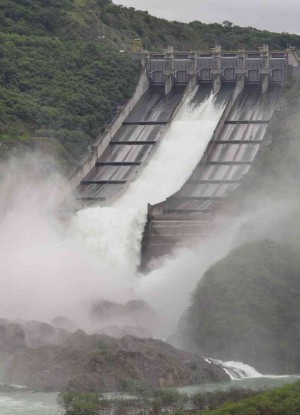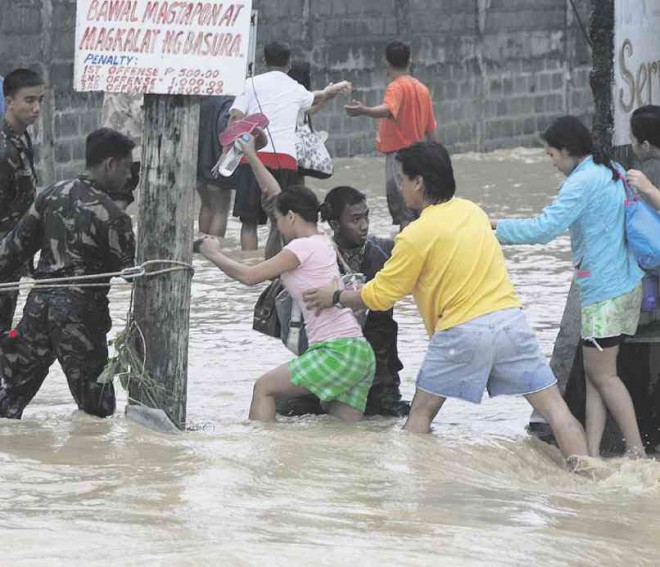Learning from ‘Pepeng’
FORMER MAYOR Nonato Abrenica of Villasis, Pangasinan province, remembers that October morning in 2009 when rampaging flood water forced its way to his town and gobbled everything in its path.
“Our town turned into a sea. Water was rising so fast that people from the evacuation centers were moving to the town hall,” says Abrenica.
It was Oct. 8, 2009. At that time, Typhoon “Pepeng” had already weakened into a tropical depression over the Cordillera mountains, three days after wreaking havoc in Cagayan province.
But the amount of rain that Pepeng had dumped over Northern Luzon was a record high, as the Philippine Atmospheric, Geophysical and Astronomical Services Administration (Pagasa) would find later.
It was more than enough to fill up dams and river systems cutting across Pangasinan.
The water that submerged the farming town had come from the Agno River, Pangasinan’s longest river, which traverses 16 towns and two cities before draining into the Lingayen Gulf.
“Three portions of the earth dike breached and that completely surprised us. We did not expect that to happen,” says Abrenica.
Nineteen more sections of the dike on both sides of the Agno River in 11 other towns would breach that day, submerging 973 of 1,356 villages in 36 towns and three cities. Sixty-three people died and the province lost about P7.4 billion worth of infrastructure, crops, fish and livestock.
The massive flooding had been largely blamed on the San Roque Dam.
Avenix Arenas, spokesperson of the province’s risk reduction and management office, recalls having repeatedly alerted San Roque Dam officials on the increasing water elevation at the reservoir.
“We were aware of an agreement then that the dam should begin spilling water once it reached 280 meters above sea level (masl),” she says.
On Oct. 3, 2009, the dam’s water level was already 280 masl and she remembers being told by dam officials that the facility could take in more water up to 290 masl.
On Oct. 7 at 12:03 a.m., officials finally opened one of the dam’s six spillway gates at a height of a meter to spillwater at the rate of 181.5 cubic meters per second (m3/s).
At that time, the dam’s water level was 286.85 masl. One cubic meter is the size of a standard balikbayan box, which is about 1,000 liters or five drums of water.
But there was simply too much rain water from Pepeng at that time that the amount of water flowing into the dam was more than the volume it was spilling.
On Oct. 8 at 11 p.m., dam officials raised all of the dam’s spillway gates at 17 m and spilled water at 3,600 m3/s. After four hours, it raised these gates to 27 m and released water at a record high rate of 5,072 m3/s.
All six gates were open at different heights for about 10 hours until Oct. 9, Arenas recalls. The volume of water overwhelmed the Agno River, which could only absorb 1,600 m3/s.
Senate investigation
The massive flooding triggered a Senate investigation and a series of meetings to review the dam’s water discharge protocol.

THE SAN ROQUE Dam in San Manuel, Pangasinan, was blamed for the widespread flooding in the province as Typhoon “Pepeng” lashed northern Luzon in 2009. ROGER TINGLE / CONTRIBUTOR
No one was punished for the disaster, which many still believed would have been prevented had the dam spilled water earlier.
“We were prepared for Pepeng,” says Gov. Amado Espino Jr. “But no amount of preparation would have been enough for that kind of flood.”
Espino says many villages were not accessible even to rubber boats and dump trucks that relief goods had to be dropped from a helicopter on roof tops.
Painful memories
There are no traces now that Pangasinan once turned into a virtual sea, except maybe for the painful memories of the victims who lost their loved ones or a property to the angry waters.
Abrenica says some people in his town, especially those living along the dike, still shudder when they hear the roaring waters of the Agno River or when the dam spills water.
When the flood receded, Abrenica recalls that he did not know where and how to start to put his town back into its feet.
“There was simply so much to be done that I even thought we would not be celebrating our town fiesta and the Talong (eggplant) Festival that January,” he says. “But before I knew it, we were back. Thanks to the help of our people.”
Changes
The breached dike has long been rebuilt and structures damaged by the flood have been repaired. Eroded roads and toppled houses in most eastern Pangasinan towns have been restored.
Arenas says many things have changed in dealing with disasters since Pepeng.In 2009, the calamity fund may only be spent once a town, city or province is declared by the legislative council under a state of calamity.
“Today, we already have Republic Act No. 10121 (Philippine Disaster Risk Reduction and Management Act of 2010), which has strengthened disaster management in the country,” she says.
Under the law, the calamity fund, now called local disaster risk reduction and management fund, has been divided into two: 70 percent as predisaster fund and 30 percent for quick response, which will be used when the province is declared under a state of calamity.
“So now, we have money to spend so that those involved in disaster response will be better equipped and better trained,” Arenas says.
“We have bought more rescue equipment, we have conducted more training on basic life support, water search and rescue and information and education campaigns in schools and villages to make people more aware,” she says.
As a result of their effort, people now listen to them and to their local officials when they are told to evacuate.
“It took Pepeng for them to realize that they should trust and obey the authorities for their own safety,” she says.
